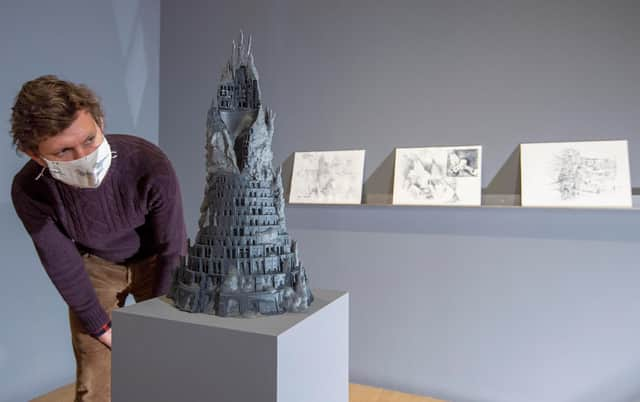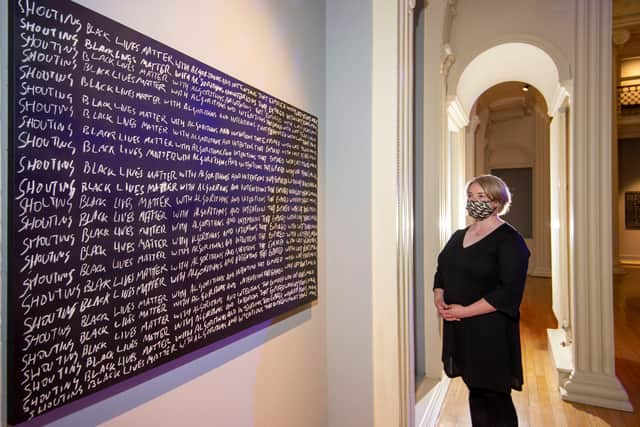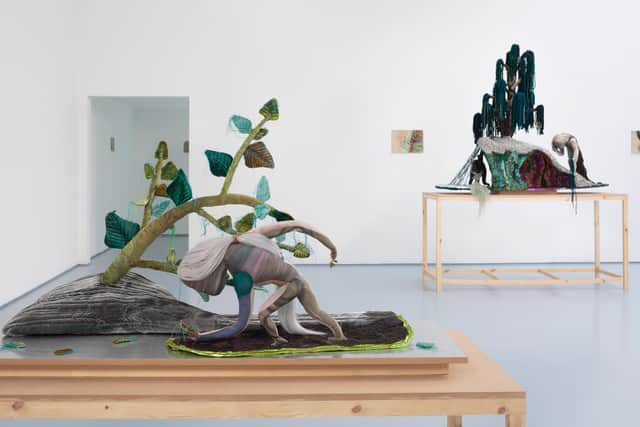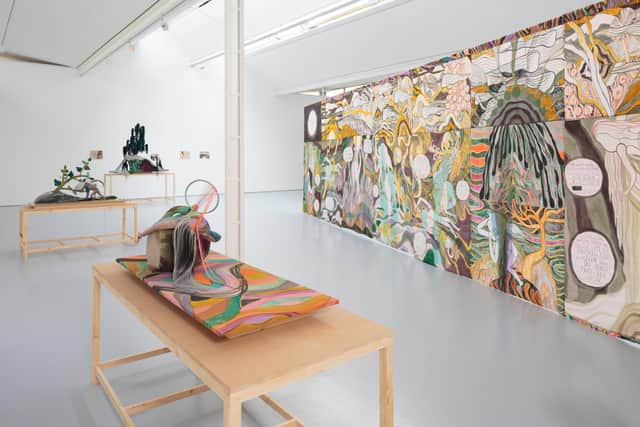Art reviews: The Normal at Talbot Rice Gallery | Emma Talbot at DCA


The Normal Talbot Rice Gallery, Edinburgh ****
Emma Talbot: Ghost Calls, Dundee Contemporary Arts ****
The word “normal” has assumed a whole new currency in the past year: when will we return to “normal”? Will things ever be “normal” again? What will “the new normal” look like? A new group show at Talbot Rice, curated during lockdown by the gallery’s Tess Giblin and James Clegg and featuring more than a dozen artists from around the world, uses the word in all these ways. While it staggers a little under the weight of all the issues it raises, it is a brave attempt to bring together all the things which have been called into question in this pandemic year.


The first work we see, loudly occupying the large space of the White Gallery, is This song is for… by South African artist Gabrielle Goliath. Working with rape survivors, she asked each of her collaborators to choose a song which was then recorded by leading female and queer musicians.
Advertisement
Hide AdIn lengthy cover versions (15-20 minutes) of well-known songs (REM’s Everybody Hurts, Save the Hero by Beyoncé), she introduces a glitch, making the singer repeat a line over and over like a live performance of a broken record. The longer this goes on – and it goes on for a very long time – the more uncomfortable it becomes. It’s a powerful metaphor for what trauma does, trapping victims in a feedback loop of experience. Here, it also doubles as a metaphor for the experience of lockdown.
If this sprawling, ambitious show has a central argument, it is to do with re-evaluating our relationship with the natural world. If Covid-19 arose because a virus jumped species, and if that came about because human beings abused nature, then – it argues – this must be the priority to address as lockdown lifts.
Solution for Normality by Jarsdell Solutions Ltd (the collaborative practice of Scotland-based artists Rae-Yen Song and Michael Barr) is less of a “solution” than a fragmented look at the problem, the lay-out of the eight-screen installation physically echoing the mutant King Rat phenomenon. New drawings and a sculpture by Anca Benera and Arnold Estefan explore deep sea vents, home to important micro-organisms but at risk of exploitative mining, and quasi botanical drawings by Alexandra Daisy Ginsberg and Sascha Pohflepp depict sinister combinations of plant and machine.


Dutch artist Femke Herregraven analyses the history of plague and its links to economic systems, while Edinburgh-based artist Tonya McMullan brings a welcome lighter note, cataloguing the different kinds of honey harvested by local beekeepers during the lockdown summer of 2020, each with a set of tasting notes. Her microscopic images of pollen are scattered (like pollen) throughout the show.
To this big issue, other big issues are added: Black Lives Matter (Kahlil Joseph’s highly acclaimed BLKNWS, which creates a collage of a new kind of broadcasting prioritising black faces and black stories, and Larry Achiampong’s clever Detention series); climate change; violence against women; immigration (James Webb’s There’s no place called home, which introduces non-native birdsong into natural locations). There’s an early work by the Boyle Family looking at population density, and a sculpture by Scotland-based artist Sarah Rose challenging the environmental issues around art-making.
There are times when The Normal feels like an a valiant attempt to bring together too many big issues under too small an umbrella, with the attendant danger that none of them is treated with quite the attention its deserves. That said, it is an important snapshot of where we are at this moment in time, and an important reminder of all the things we said we would try to do differently in the post-Covid world.
Advertisement
Hide AdEmma Talbot’s solo show for DCA, Ghost Calls, was made during the first lockdown and was due to open in December, but had to be postponed for four months. While it has been in planning since 2018, the work has shifted in the last year to address the post-pandemic moment more directly. In essence, it is occupied with similar questions to The Normal: what is important as we emerge from the wreckage of the last year? What should we try to do differently?


The approach taken by Talbot, who won the Max Mara Art Prize for Women in 2020, is very different. While The Normal started with the issues, a starting point for her was a Celtic revival painting by John Duncan in the McManus Art Gallery, Riders of the Sidhe. From Duncan’s procession of mythical beings, she moved on to look at the Celtic tradition of keening – professional mourners who attended a death to help escort the soul into the next world.
Advertisement
Hide AdOn two large-scale silk banners, she has painted a narrative of a “crash” which collapses the structures of the familiar world (she admits this didn’t require too much imagining in 2020) and a journey through the post-crash landscape, lead by the keening women, towards a new way of being.
Each element of the show – the words, paintings, banners, hand-made fabric and papier-mache sculptures and animated film – enriches the central proposition. In the paintings, there are images of creatures from Pictish carving, echoes of Scottish landscapes, of William Blake, mythology and ghosts. The film hints at a personal grief which becomes emblematic of something much bigger.
The sculptures, in particular, are beautifully made, and capture Talbot’s female protagonist (who looks a little bit like herself) striving to climb a mountain, being buffeted by winds, mourning, dreaming, picking up a leaf and seeing hints of new life. Their handmade nature means they are imbued with a kind of loving attention.
There are times when the work’s mystical overtones tip over into psychedelic new-age talk (“harmonising with ancient symphonies, astral and earthly”). But the core of it is much wiser, more human and more empathetic. It better the grieve what is lost, it suggests, and let it go, “accepting our state as terribly fragile and magically robust.”
Where The Normal gives us big issues to chew over, Ghost Calls invites us into a future where we are kinder to ourselves, one another and the planet. Part intentional, part serendipity, it is somehow exactly what we need to hear as we re-emerge into a world which is a little more normal than the one we’ve known for the past year.
The Normal runs until 29 August; Emma Talbot, until 8 August
A message from the Editor:
Advertisement
Hide AdThank you for reading this article. We're more reliant on your support than ever as the shift in consumer habits brought about by coronavirus impacts our advertisers.
If you haven't already, please consider supporting our trusted, fact-checked journalism by taking out a digital subscription at https://www.scotsman.com/subscriptions